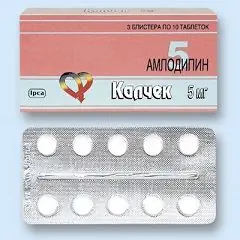- Author Rachel Wainwright [email protected].
- Public 2023-12-15 07:39.
- Last modified 2025-11-02 20:14.
Kulchek
Kalchek: instructions for use and reviews
- 1. Release form and composition
- 2. Pharmacological properties
- 3. Indications for use
- 4. Contraindications
- 5. Method of application and dosage
- 6. Side effects
- 7. Overdose
- 8. Special instructions
- 9. Application during pregnancy and lactation
- 10. Use in childhood
- 11. In case of impaired renal function
- 12. For violations of liver function
- 13. Use in the elderly
- 14. Drug interactions
- 15. Analogs
- 16. Terms and conditions of storage
- 17. Terms of dispensing from pharmacies
- 18. Reviews
- 19. Price in pharmacies
Latin name: Calchek
ATX code: C08CA01
Active ingredient: Amlodipine (Amlodipine)
Manufacturer: IPCA LABORATORIES, Ltd. (India)
Description and photo update: 2018-25-10
Prices in pharmacies: from 152 rubles.
Buy

Kalchek is a slow calcium channel blocker that has antihypertensive and antianginal effects.
Release form and composition
Dosage form Kalchek - tablets: round, with beveled edges, flat, with a line on one side, from almost white to white [10 and 14 pcs. in blister packs (blisters), in a cardboard box 2 blisters of 14 tablets or 3 blisters of 10 tablets].
Composition of 1 tablet:
- active ingredient: amlodipine (in the form of besylate) - 5 or 10 mg;
- excipients: sodium carboxymethyl starch, talc, calcium hydrogen phosphate, magnesium stearate, colloidal silicon dioxide, corn starch.
Pharmacological properties
Pharmacodynamics
Amlodipine - the active substance of Kalchek - is a derivative of dihydropyridine. Has hypotensive and antianginal effects. By binding to dihydropyridine receptors, the drug blocks slow calcium channels, and also inhibits the transmembrane transition of calcium into vascular cells and heart smooth muscle (to a greater extent in vascular smooth muscle cells than in cardiomyocytes).
The mechanism of the antihypertensive action of amlodipine is associated with its ability to have a direct relaxing effect on vascular smooth muscle.
The drug reduces myocardial ischemia in two ways:
- Expands arterioles, thereby reducing total peripheral resistance (afterload). At the same time, it practically does not affect the heart rate, as a result of which energy consumption and myocardial oxygen demand are reduced.
- Expands peripheral and coronary arteries and arterioles, including in ischemic zones of the myocardium, as a result of which it prevents the development of coronary spasm in smokers, increases the flow of oxygen into the myocardium in patients with Prinzmetal angina (vasospastic angina).
In case of arterial hypertension, the daily dose of the drug provides a smooth decrease in blood pressure (BP) within 24 hours (in the supine and standing position).
With angina pectoris, the daily dose of Kalchek reduces the frequency of angina attacks, increases the time of exercise, reduces the consumption of nitroglycerin, delays the development of the next attack of angina and ST segment depression (by 1 mm) against the background of physical exertion.
In patients with diseases of the cardiovascular system (including coronary atherosclerosis with damage from one vessel to stenosis of three or more arteries, atherosclerosis of the carotid arteries) and angina pectoris, as well as in patients who have undergone percutaneous transluminal angioplasty of the coronary arteries (TPC) or myocardial infarction, Kalchek reduces the risk of hospitalization due to chronic heart failure (CHF) and unstable angina pectoris, reduces the frequency of interventions aimed at restoring coronary flow, prevents the development of thickening of the carotid intima media and stroke, as well as the need for coronary artery bypass grafting and TLP.
Kalchek does not increase the risk of complications and deaths in patients with CHF III - IV functional class (NYHA classification) during therapy with diuretics, angiotensin-converting enzyme (ACE) inhibitors, and digoxin. In CHF III - IV functional class of non-ischemic etiology, the drug increases the risk of pulmonary edema.
Amlodipine does not adversely affect plasma lipid concentration and metabolism.
Pharmacokinetics
After oral administration, amlodipine is slowly but almost completely (90%) absorbed from the gastrointestinal tract. Its absolute bioavailability varies within 64-80%. The maximum concentration in blood serum reaches after 6-9 hours, equilibrium concentrations are observed after 7-8 days of regular administration of the drug. Food does not affect absorption and efficiency.
Most of the drug is concentrated in the tissues, less in the blood. Amlodipine is characterized by a high bond with plasma proteins - about 97%. It is metabolized in the liver to form inactive metabolites.
The half-life (T ½) after a single dose of amlodipine inside averages 35 hours. Approximately 60% of the received dose is excreted by the kidneys (most - in the form of metabolites, about 10% - unchanged), 20-25% of the dose - through the intestines with bile.
T ½ in patients with arterial hypertension increases to 48 hours, in patients over 65 years of age - up to 65 hours. However, the change in time T ½ has no clinical significance.
With concomitant liver failure, T ½ increases. With prolonged use, the accumulation of amlodipine in the body will be higher.
With concomitant renal failure, a significant change in the kinetics of amlodipine is not observed.
The drug crosses the blood-brain barrier.
It is not excreted during hemodialysis.
Indications for use
- arterial hypertension - as a mono-drug or in combination with other antihypertensive drugs;
- Prinzmetal's angina pectoris and stable exertional angina pectoris - as a single drug or in combination with other antianginal drugs.
Contraindications
- severe aortic stenosis;
- unstable angina (with the exception of Prinzmetal's angina);
- severe arterial hypotension (systolic blood pressure less than 90 mm Hg);
- age up to 18 years;
- hypersensitivity to the components of Kalchek or other dihydropyridine derivatives.
Carefully:
- chronic heart failure of non-ischemic etiology (III - IV functional class according to the NYHA classification);
- sick sinus syndrome (severe bradycardia, tachycardia);
- aortic / mitral stenosis;
- arterial hypotension;
- acute myocardial infarction (and within 1 month after);
- hypertrophic obstructive cardiomyopathy;
- impaired liver function;
- elderly age.
Instructions for the use of Kalchek: method and dosage
Kalchek is taken orally once a day.
The initial daily dose for adults is 5 mg, in the future it can be increased to 10 mg.
The maintenance dose for hypertension is 5 mg.
No dose adjustment of Kalchek is required while concurrent administration of ACE inhibitors, beta-blockers or thiazide diuretics.
Side effects
- on the part of the cardiovascular system: peripheral edema (swelling of the ankles and feet), a marked decrease in blood pressure, palpitations; rarely - chest pain, vasculitis, cardiac arrhythmias (ventricular tachycardia, bradycardia, atrial flutter), orthostatic hypotension, myocardial infarction; very rarely - migraine, extrasystole, development or aggravation of existing heart failure;
- from the respiratory system: rhinitis, shortness of breath; very rarely - cough;
- from the digestive system: epigastric pain, nausea, vomiting; rarely - dryness of the oral mucosa, gingival hyperplasia, thirst, constipation / diarrhea, flatulence, hyperbilirubinemia, anorexia, jaundice, increased activity of hepatic transaminases, hepatitis, pancreatitis; very rarely - increased appetite, gastritis;
- on the part of the hematopoietic organs: very rarely - thrombocytopenia, leukopenia, thrombocytopenic purpura;
- from the central nervous system: a feeling of heat and flushes of blood to the skin of the face, increased fatigue, headache, mood changes, drowsiness, dizziness, convulsions; rarely - nervousness, malaise, loss of consciousness, vertigo, emotional lability, unusual dreams, anxiety, insomnia, fainting, tremor, depression, peripheral neuropathy, paresthesia, asthenia, hypesthesia; very rarely - agitation, apathy, amnesia, ataxia;
- on the part of the genitourinary system: rarely - violation of sexual function (including decreased potency), painful urge to urinate, frequent urination, nocturia; very rarely - an increase in the volume of excreted urine, a violation of the urination process;
- on the part of the musculoskeletal system: rarely - back pain, muscle cramps, arthralgia, arthrosis; with prolonged use - myalgia; very rarely - myasthenia gravis;
- skin and allergic reactions: rash (including urticaria, erythematous and maculopapular rash), pruritus, erythema multiforme, angioedema; very rarely - dermatitis, skin pigmentation disorders, purpura, xeroderma;
- others: rarely - eye pain, conjunctivitis, diplopia, blurred vision, dyspnea, ringing in the ears, increased sweating, nosebleeds, hyperglycemia, hyperuricemia, gynecomastia, weight gain / loss; very rarely - violation of taste, cold sticky sweat, xerophthalmia, violation of accommodation, parosmia.
Overdose
Symptoms: tachycardia, marked decrease in blood pressure, excessive peripheral vasodilation. Development of severe and persistent arterial hypotension, including shock, is possible.
Therapeutic first aid measures, especially if 2 hours have not passed since the overdose, involve gastric lavage and the intake of activated charcoal. Hemodialysis is ineffective. Further treatment is aimed at maintaining cardiovascular function. It is necessary to monitor the indicators of heart and lung function, the volume of diuresis and circulating blood. To eliminate the consequences of calcium channel blockade, intravenous administration of calcium gluconate is indicated. To restore vascular tone, vasoconstrictors are prescribed (provided that there are no contraindications to their use).
special instructions
In hypertensive crisis, the effectiveness and safety of Kalchek have not been established.
During therapy, it is necessary to control body weight and sodium intake, as well as the appointment of an appropriate diet.
To prevent bleeding, soreness, and gingival hyperplasia, you should maintain good oral hygiene and visit your dentist frequently.
Slow calcium channel blockers do not cause withdrawal syndrome, however, therapy should be discontinued gradually, gradually reducing the dosage.
Patients of short stature, low body weight, as well as with concomitant impairments of hepatic function, may require a lower dose of Kalchek.
Amlodipine does not affect plasma concentrations of low density lipoproteins, triglycerides, glucose, creatinine, total cholesterol, uric acid, uric acid nitrogen, potassium ions.
Influence on the ability to drive vehicles and complex mechanisms
Due to the risk of adverse events from the central nervous system (for example, drowsiness or dizziness), it is recommended to exercise caution during the period of therapy when doing activities that require speed of reactions and / or increased attention.
Application during pregnancy and lactation
Due to the lack of data on the safety of amlodipine during pregnancy, Kalchek can be used only in exceptional cases, if the benefits to the woman outweigh the risks to the fetus.
Whether the drug is excreted in breast milk is unknown. However, it has been found that other blockers of slow calcium channels, which are derivatives of dihydropyridine, pass into breast milk. For this reason, breastfeeding should be discontinued if Kalchek therapy is necessary during lactation.
Pediatric use
According to the instructions, Kalchek is not used in pediatrics (for the treatment of children and adolescents under 18 years of age) due to the lack of clinical experience of use.
With impaired renal function
Patients with renal insufficiency do not need a dose adjustment of Kalchek.
For violations of liver function
Patients with impaired hepatic function during treatment should be closely monitored. No dose adjustment of Kalchek is usually required.
Use in the elderly
The drug should be used with caution when treating elderly patients (over 65 years old). No dose adjustment is usually required. In the event of an increase in the dosage of Kalchek, careful monitoring is necessary.
Drug interactions
There is no clinically significant interaction of Kalchek with cimetidine, nonsteroidal anti-inflammatory drugs (especially with indomethacin).
Amlodipine has no effect on the pharmacokinetic parameters of warfarin and digoxin.
Concomitant administration of sildenafil (at a dose of 100 mg) with essential hypertension does not affect the pharmacokinetic parameters of amlodipine.
Loop and thiazide diuretics, ACE inhibitors, nitrates, beta-blockers and verapamil enhance the hypotensive and antianginal effects of amlodipine. Calcium supplements can reduce its effect.
Means for inhalation anesthesia (hydrocarbon derivatives), antipsychotics (antipsychotics), alpha 1 -adrenergic blockers, quinidine, isoflurane, amiodarone can enhance the hypotensive effect of Kalchek.
Antiviral agents (eg, ritonavir) increase plasma concentrations of amlodipine.
Kalchek can increase the manifestations of neurotoxicity of lithium preparations (nausea, diarrhea, vomiting, tremors, ataxia, tinnitus).
Presumably, inhibitors of liver microsomal enzymes increase the plasma concentration of amlodipine and increase the risk of side effects, and inducers of liver microsomal enzymes decrease its plasma concentration.
Analogs
Kalchek's analogs are: Amlovas, Amlodigamma, Amlodak, Amlodipine, Amlodipine Cardio, Amlodipine Alkaloid, Amlodipine Sandoz, Amlodipine Cardio, Amlodipine Zentiva, Amlodipine-Borimed, Amlodipine-Biocom, Amlodipine-Ajlodipine, Amphlodipine, Amlodipine-Teva, Amlocard-Sanovel, Amlonorm, Amlodipharm, Amlong, Amlorus, Vero-Amlodipine, Amlotop, Corvadil, Karmagip, Cardilopin, Normodipin, Norvask, Cordi Cor, Stamlo M.
Terms and conditions of storage
Store in a dry, out of reach of children, protected from light, at temperatures up to 25 ° C.
The shelf life is 3 years.
Terms of dispensing from pharmacies
Dispensed by prescription.
Reviews about Kalchek
Reviews about Kalchek are mostly positive. Patients note the high efficacy of the drug when used according to indications, as well as the relatively low cost. An additional advantage is the convenience of taking - once a day, thereby reducing the negative effect of the drug on the gastrointestinal tract. At the same time, they emphasize that the Kalchek effect is really enough for a day.
Side effects are described as disadvantages of the drug.
Price for Kalchek in pharmacies
Approximate prices for Kalchek (30 tablets per pack): 5 mg tablets - 155-175 rubles, 10 mg tablets - 265-315 rubles.
Kalchek: prices in online pharmacies
|
Drug name Price Pharmacy |
|
Kalchek 5 mg tablets 30 pcs. 152 RUB Buy |
|
Kalchek 10 mg tablets 30 pcs. 199 RUB Buy |
|
Kalchek tablets 10mg 30 pcs. 303 RUB Buy |

Anna Kozlova Medical journalist About the author
Education: Rostov State Medical University, specialty "General Medicine".
Information about the drug is generalized, provided for informational purposes only and does not replace the official instructions. Self-medication is hazardous to health!






